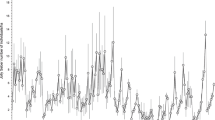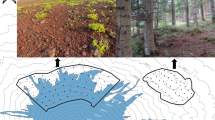Abstract
White-footed mice, Peromyscus leucopus noveboracensis, and deer mice, P. maniculatus nubiterrae, occur sympatically throughout much of the Appalachian Mountains of the eastern United States. Previous studies have shown that these two species are behaviorally and ecologically similar and do not partition food or microhabitat. In this paper I use a 14-year data set to demonstrate that the two species have differential population growth and survival rates in response to food abundance and season, which may mediate their coexistence. The ratio of white-footed mice to deer mice ranged from 0.5:1 to 6:1. During summer and times of tood abundance, white-footed mice gained a numerical advantage over deer mice in 10 of 14 years, whereas following winter and poor food production, deer mice had higher survival in 9 of 13 years. The major decline in white-foote mice, but not deer mice, was associated with poor mast (acorn) production in autumn. Differential survival of deer mice may be due to their physiological adaptations to cold temperature and efficient use of torpor during food shortage. Inter-year variance in food production and climatic conditions appear to change the competitive advantage of each species often enough to permit coexistence. Coexistence of these two ecologically similar species may be maintained by different physiological limitations in a fluctuating environment.
Similar content being viewed by others
References
Barry RE Jr, Bottie MA, Grantham LB (1984) Vertical stratification of Peromyscus leucopus and P. maniculatus in southwestern Virginia. J Mammal 65:145–148
Brown JH, Davidson DW, Munger JC, Inouye RS (1986) Experimental community ecology: the desert granivore system. In: Diamond J, Case TJ (eds) Community ecology, Harper and Row, New York, pp 41–62
Bruseo JA, Barry RE Jr (1995) Temporal activity of syntopic Peromyscus in the central Appalachians. J Mammal 76:78–82
Chesson P (1994) Multispecies competition in variable environments. Theor Popul Biol 45:227–276
Chesson P, Huntley N (1989) Short-term instabilities and long-term community dynamics. Trends Ecol Evol 4:293–298
Chesson P, Rosenzweig ML (1991) Behavior, heterogeniety, and the dynamics of interacting species. Ecology 72:1187–1195
Connell JH (1971) On the role of natural enemies in preventing competitive exclusion in some marine animals and in rain forest trees. In: Boer PJ de, Gradwell GR (eds) Dynamics of populations (Proceedings of the Advanced Study Institute in Dynamics of Numbers in Populations, Oosterbeck). Centre for Agricultural Publishing and Documentation, Wageningen, pp 298–310
Dooley JL, Dueser RD (1990) An experimental examination of nest-site segregation by two Peromyscus species. Ecology 71:788–796
Gause GF (1934) The struggle for existence. Williams and Wilkins, Baltimore
Grant PR (1972) Interspecific competition among rodents. Annu Rev Ecol Syst 3:79–106
Graves S, Maldonado J, Wolff JO (1988) Vertical habitat segregation between Peromyscus leucopus and Peromyscus maniculatus. Can J Zool 66:276–278
Hall ER (1981) The mammals of North America, 2nd edn. Wiley, New York
Harney BA, Dueser RD (1987) Vertical stratification of activity of two Peromyscus species: an experimental analysis. Ecology 68:1084–1091
Hutchinson GE (1961) The paradox of the plankton. Am Nat 95:137–145
Klein HG (1960) Ecological relationships of Peromyscus leucopus noveboracensis and P. maniculatus gracilis in central New York, Ecol Monogr 30:387–407
Lack D (1971) Ecological isolation in birds. Blackwell, Oxford
MacArthur RH (1985) Population ecology of some warblers of northeastern coniferous forests. Ecology 39:599–619
Ostfeld RS, Jones CG, Wolff JO (1996) Of mice and mast: ecological connections in eastern deciduous forests. Bioscience 46:323–330
Parren SG, Capen DE (1985) Local distribution and coexistence of two species of Peromyscus in Vermont. J Mammal 66:36–44
Pierce SS, Vogt FD (1993) Winter acclimatization in Peromyscus maniculatus gracilis, P. leucopus noveboracensis, and P. l. leucopus. J Mammal 74:665–677
Schoener TW (1974) Resource partitioning in ecological communities. Science 185:27–39
Smith DA, Speller SW (1970) The distribution and behavior of Peromyscus maniculatus gracilis and Peromyscus leucopus noveboracensis (Rodentia: Cricetidae) in a southeastern Ontario woodlot. Can J Zool 48:1187–1199
Sousa WP (1979) Disturbance in marine intertidal boulder fields: the nonequilibrium maintenance of species diversity. Ecology 60:1225–1239
Stephenson SL (1982) A gradient analysis of slope forest communities of the Salt Pond Mountain Area in southwestern Virginia. Castanea 47:301–215
Tadlock CC, Klein HG (1979) Nesting and food storage behavior of Peromyscus maniculatus gracilis and Peromyscus leucopus noveboracensis. Can Field-Nat 93:239–241
Tannebaum MG, Pivorun EB (1987) Differential effect of food restriction on the induction of daily torpor in Peromyscus maniculatus and P. leucopus. J Thermoregul Biol 12:159–162
Tannebaum MG, Pivorun EB (1988) Seasonal study of daily torpor in southeastern Peromyscus maniculatus and Peromyscus leucopus from mountains and foothills. Physiol Zool 51:10–16
Wiens JA (1977) On competition and variable environments. Am sci 54:273–287
Wolff JO (1985a) Comparative population ecology of Peromyscus leucopus and Peromyscus maniculatus. Can J Zool 63:1548–1555
Wolff JO (1985b) The effects of density, food, and interspecific interference on home range size in Peromyscus leucopus and Peromyscus maniculatus. Can J Zool 63:2657–2662
Wolff JO (1986) Life history strategies of white-footed mice (Peromyscus leucopus). Va J Science 37:208–220
Wolff JO (1989) Social Behavior. In: Kirkland GL, Layne JN (eds) Advances in the biology of Peromyscus 1968–1986. Texas Tech Misc Publ, Lubbock, Texas, pp 271–291
Wolff JO (1993) Does the “Chitty effect” occur in Peromyscus? J Mammal 74:846–851
Wolff JO (1994) Reproductive success of solitarily and communally nesting white-footed mice. Behav Ecol 5:206–209
Wolff JO (1996) Population fluctuations of mast-eating rodents are correlated with acorn production. J Mammal, in press
Wolff JO, Dueser RD (1986) Noncompetitive coexistence between Peromyscus spp. and Clethrionomys gapperi. Can Field-Nat 100:186–191
Wolff JO, Durr DS (1986) Winter nesting behavior of Peromyscus leucopus and Peromyscus maniculatus. J Mammal 67:409–411
Wolff JO, Hurlbutt B (1982) Day refuges of Peromyscus leucopus and Peromyscus maniculatus. J Mammal 63:666–668
Wolff JO, Freeberg MH, Dueser RD (1983) Interspecific territoriality in two sympatric species of Peromyscus (Rodentia: Cricetidae). Behav Ecol Sociobiol 12:237–242
Wolff JO, Dueser RD, Berry KS (1985) Food habits of Peromyscus leucopus and Peromyscus maniculatus. J Mammal 66:795–798
Zegers DA, Merritt JF (1988) Adaptations of Peromyscus for winter survival in an Appalachian montane forest. J Mammal 69:516–523
Author information
Authors and Affiliations
Rights and permissions
About this article
Cite this article
Wolff, J.O. Coexistence of white-footed mice and deer mice may be mediated by fluctuating environmental conditions. Oecologia 108, 529–533 (1996). https://doi.org/10.1007/BF00333730
Received:
Accepted:
Issue Date:
DOI: https://doi.org/10.1007/BF00333730




